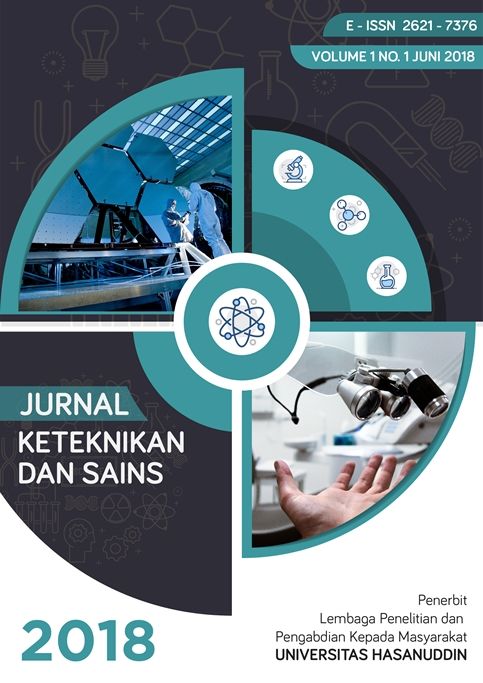STUDI HYDRAULIC CONDUCTIVITY CLAY LINER DENGAN VARIASI TINGKAT KEPADATAN TERTENTU TERINFILTRASI AIR LINDI
Abstract
Penelitian ini bertujuan mengetahui berapakoefisien hydraulic conductivity yang dimiliki tanah pada tingkatkepadatan tertentu yang dialiri media air lindi. Sampel tanahmerupakan material pilihan berupa lempung kelanauan yang merupakan material yang sesuai untukdipergunakan sebagai lapisan kedap clay liner pada sistem sanitary landfill. Tanahtersebut dipadatkan sesuai dengan standar Modified Proctor dandipersiapkan dalam 3 kondisi kadar air,yaitu kondisi kering,kadar air optimum dan kondisi jenuh. Juga dipersiapkankondisi 90% maksimum sebagai standar kriteriaclayliner. Penentuan hidraulic conductivity diuji dengan metode “falling head” yang sesuai untuk tanah berbutir halus. Proses pengujian dilakukan dengan 3 kondisi yaitu: infiltrasi air lindi, infiltrasi air suling, dan infiltrasi dengan air suling, kemudian disusul dengan infiltrasi dengan menggunakan lindi.
Hasil penelitian menunjukkan bahwa terjadi peningkatan besarankonduktivitas pada media air lindi seiring dengan peningkatan porositas sertakecenderunganpenurunan yangcukup besar pada kondisi jenuh yang nilainya mendekati kondisi dengan infiltasi air suling.
Kata kunci: hydraulic conductivity,clay liner, air lindi,tingkat kepadatan.
ABSTRACT
This research aimed to find out the number of hydraulic conductivity coefficient that soil has in a certain level of density drained by leachate. Soil sample is a chosen material in the form of silty clay which is a suitable material as impermeable layer of clay liner in the sanitary landfill system. Those soil is compacted based on Modified Proctor standard and prepared in 3 water contents; dry, optimum water content, and saturated. 90% of maximum condition as standard criterion of linier clay is also prepared. The determination of hydraulic conductivity is tested with falling head method that is suitable for fine-grained soil. The testing process is done by 3 conditions; infiltration of leachate, infiltration of distilled water, and infiltration with distilled water, then followed by infiltration using leachate.
The result of this research shows that the increasing amount of conductivity on water medium occurs along with the increasing of porosity and a significant decreasing trend on saturated condition with the value comes near to distilled water infiltration condition
Keywords : hydraulic conductivity, clay liner, leachate, density level.
References
Arifin, Yulian Firman, dan Noor Endah Mochtar, 2002. Pengaruh Leacheate Sampah Perkotan Terhadap Hidrolik Conductivity Clay Liner, Prosiding Pertemuan Ilmiah Geoteknik (VI) : V1-9
Arifin, Fauzi, 2001. Sistem Pengelolaan TPA di Kota Makassar, Tesis Program Pasca Sarjana UNHAS
Coduto, Donalad P, 1999. Geotechnical Engineering: Principal and Practices, Prentice Hall.
Qasim, Syed R, and Walter Chiang, 1994. Sanitary Landfill Leacheate, Technomic Publishing Company, Inc.
Rahman, Natalia, dan Nurjannatun, 2006. Evaluasi Pengelolaan Sampah Padat pada TPA Tamangapa, Tugas Akhir Teknik Sipil Universitas ’45 Makassar
Rowe, R. Kerry, 2000. Geotechnical and Geoenviromental Enggineering, Kluwer Academic Publisher, London, 721-729.
Rollings, Marian.P.PE, and Raymond S. Rolllings,JR.PE, 1996. Geotechnical Materials in Construction, Mc. Graw Hill, 450-459.
S. Dutta, and D. Cornell, 1996. Inter Relationships and Realistics Implication of Soil Leaching Method, Proceeding of the 3rd International Symposium Environmental Geotechnics, 3(1) : 125-136.
Shaktour K.M, and Daignault L.G, 1996. A Study on Factors Affecting the Permeability of Clay Liner, Proceeding of the 3rd International Symposium Environmental Geotechnics, 3(1) : 255-262.
Nataraj,M.s, and Sinduvalli, K.L, 1996. Evaluation of Leakage Rates and Pollutant Transport from Landfill, Proceeding of the 3rd International Symposium Environmental Geotechnics, 3(1) : 272-281.
Rowe, R. Kerry, 2009. System Engineering The Design and Operational of Munificial Solid Waste Landfills to Minimize Contamination of Ground Water, Proceeding of International Symposium on Geoenvironmental Engineering in Hangzou China (p. 3), e-ISBN 978-3-642-04460-1

